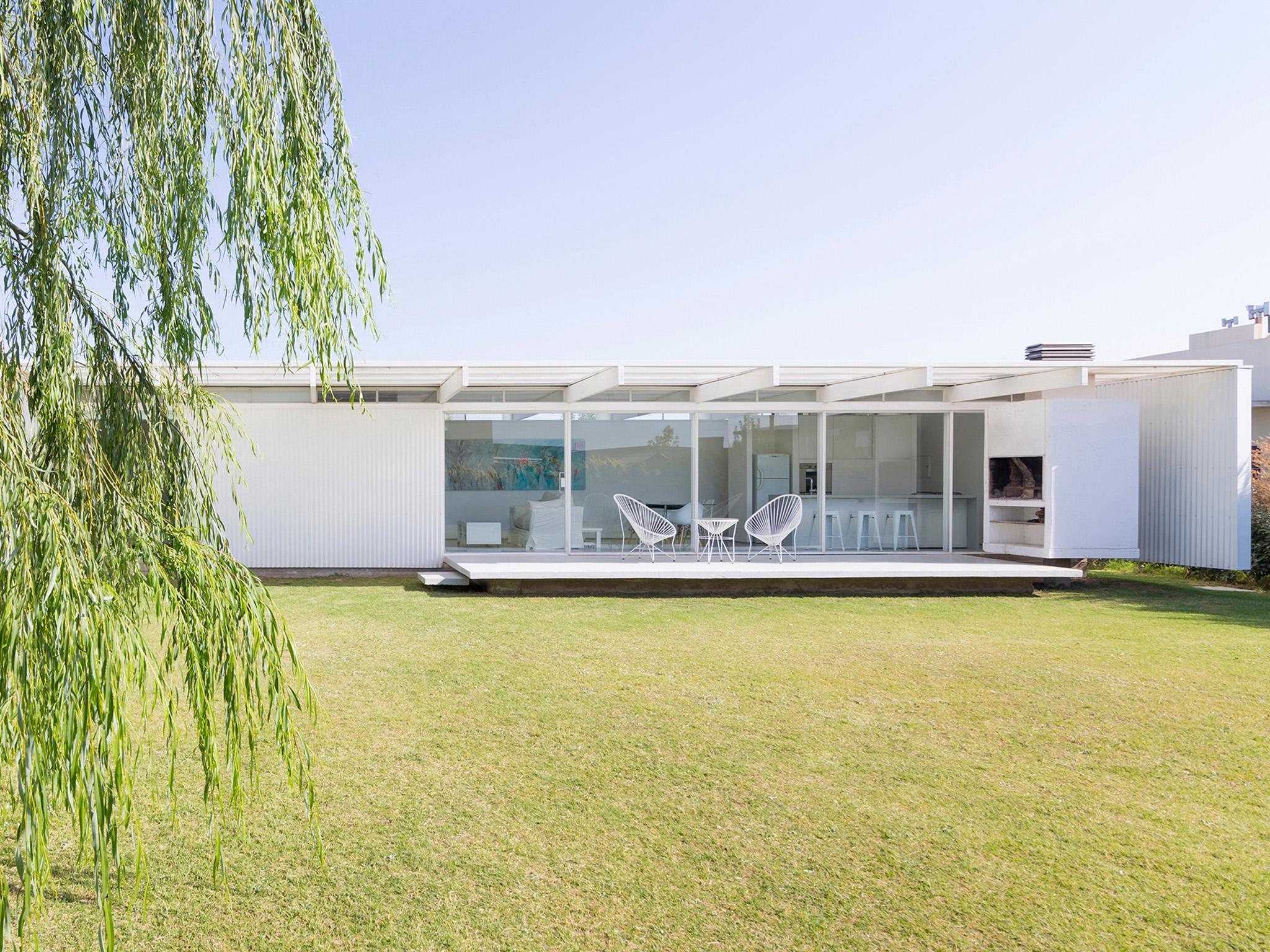Inspiring home of the week: All white minimalism in Bahía Blanca
Sitting on the gateway to Patagonia, this minimalist home would not look out of place in Southern California

This all white residence in the city of Bahía Blanca, in Argentina, would not look out of place in the Hollywood hills. A narrow home built for a single person was expanded during construction to house the owner’s growing family.
The El Maitén residence, named after the wealthy neighbourhood in which the house is located, was designed by Buenos Aires architect Bernardo Rosello, who chose to focus on craftsmanship rather than avant-garde.
The living area is open plan and spans a back window which allows air and light to circulate throughout the building. The purposeful overhanging roof at the rear provides shade in summer and protection from the prevailing winds typical at the edge of the Patagonian region.
We talked to Bernardo Rosello about his minimalist masterpiece.
Please tell us a little about your practice
I have been practising for 20 years – 46 [is] my age. I had several work stages, among them I lived [for] nine years in Rome. In the last six years, I [have lived] in Bahía Blanca, a city located geographically where Patagonia begins and the Pampa ends. My office is a minimal structure, which is reconfigured for each assignment with the model of “association” [with] different professionals. For the associated professional the stimulus is greater, as well as the responsibility. The new communication technologies allow [me] to [disaggregate] the study [into] different parts of the world.
El Maitén Residence – Bahía Blanca, Argentina
Show all 17What is your practice known for?
I would say ... by the will to understand the place where it is located: its climate, its visuals, the landscape. [Also] constructive synthesis, spatial clarity, the absence of ornament, honesty [of] material and the use of simple shapes and geometries.
How would you sum up the project in five words?
Poetry, purism, common sense, rationality [and] synthesis.
What was the brief for this project?
As I write in the project report, I can [provide] in a few square metres – with limited economic resources – a work for its sole user; but at the same time the project foresees its second stage in an orderly manner in the future, and without altering the formal consistency of the work.
What did you hope to solve as you designed this home?
In the field of [the] functional, everything requested by the client, clearly. But at the same time, [I wanted to] take advantage of this particular case to apply and verify those principles that interest me about architecture: light, material, site... No matter the programme, the scale [or] the complexity, the problems of architecture are always the same.
What makes this space unique?
I think that this question should be answered by the client [but] I intend to expand. Personally, I do not believe that one can think a priori in a “unique space”, that has nothing to do with the role of the architect, but with the perception that human beings have of spaces, based on their subjectivity. [It is not necessary that] a space of “unique” architectural quality should have any power over people as it can also happen that an absolutely vulgar space, from the architectural [point of view], is the most important for a person, based on their sensitivity [and] given by their experiences spent in [that space]. I do not believe that an architect can accurately predict how a certain space will be felt, I do not believe in such manipulative power. This happens independently of the will of the designer.
What was your inspiration for this project?
Inspirations are multiple [and] historically disordered. I consider the classical modernity of the first decades of the last century the point of departure – with its maximum qualitative expression in the [19]50s – and that, it has not yet been possible to “demolish” by any cultural fashion, [despite] constant failed attempts. However I think there are many masters in the present [day] with outstanding works, including Eduardo Souto de Moura or Peter Zumthor.
What was the toughest issue you encountered when this building was being designed and built?
The difficulties are not [small in number], but I would [particularly] emphasise the continuous loss of quality in the different [crafts] that take part in the construction of a [project]. In Argentina, for this scale of works in general, craftsmanship predominates over industrialisation.
What do you wish you could change, in hindsight?
It could be perfecting a project to the infinite [degree], but neither the [time for] production, nor the client would allow [that]; so I answer: there are many things that I would modify – without [self] criticism there is no evolution. Consequently, those flaws that I detect, probably invisible to the user, are what will motivate me for a new project.
What sort of experience do you hope people using this space have?
What I hope is that it be verified in the use [in which it] was thought, drawn and built. When [the] project came into permanent contact with the user – I know him as a person, [his] habits, customs, needs – then the project [acquired] a specific shape made, in appearance, to measure; but simultaneously, [and] once these specific needs are solved, I [tried] to make the work of architecture transcend its own nature – the [idea] that [had] originated it – so that its language [became] universal. My approach is not original, many try to achieve it.
Subscribe to Independent Premium to bookmark this article
Want to bookmark your favourite articles and stories to read or reference later? Start your Independent Premium subscription today.

Join our commenting forum
Join thought-provoking conversations, follow other Independent readers and see their replies